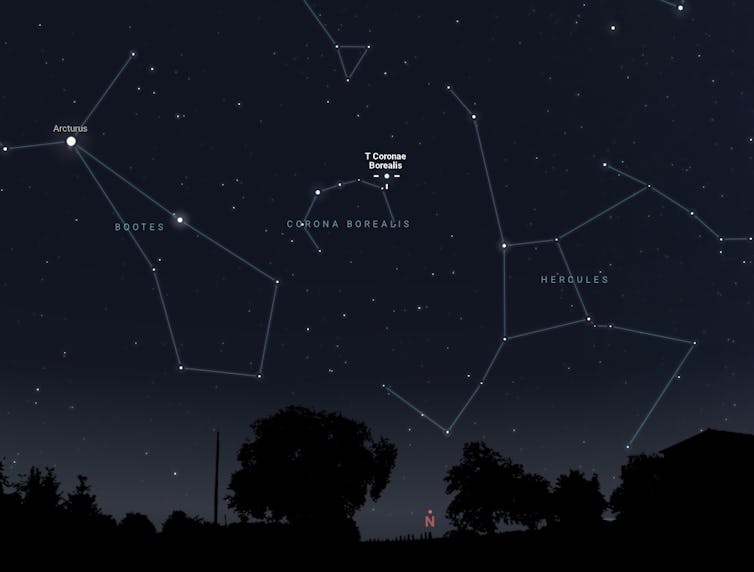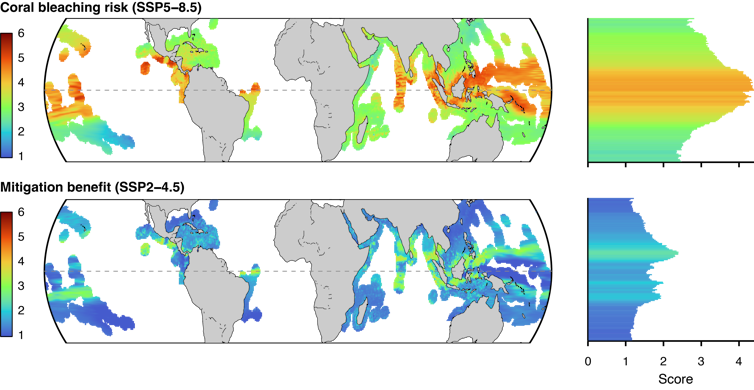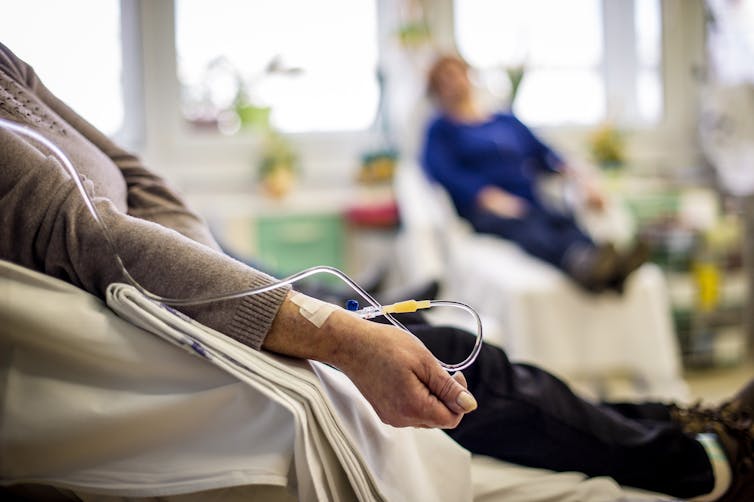 |
| Shutterstock |
Monday, 12 August 2024
Polling on American perceptions of internal conflict in the United States
The value of Unions and the right to protest
 |
| Electrical Trades Union protest 2024 (c) Sentinel Owl |
- 12.5% of employees in the total workforce were trade union members
- Since 1992, the proportion of employees who were trade union members has fallen from 41% to 12.5%
- The Education and training industry (30%) and the Professionals occupation group (19%) had the highest rates of trade union membership.
Tuesday, 9 July 2024
A Star is born
Look up! A once-in-a-lifetime explosion is about to create a ‘new’ star in the sky

Any night now, a “new star” or nova will appear in the night sky. While it won’t set the sky ablaze, it’s a special opportunity to see a rare event that’s usually difficult to predict in advance.
The star in question is T Coronae Borealis (T CrB, pronounced “T Cor Bor”). It lies in the constellation of the northern crown, prominent in the Northern Hemisphere but also visible in the northern sky from Australia and Aotearoa New Zealand over the next few months.
Most of the time T CrB, which is 3,000 light years away, is much too faint to be seen. But once every 80 years or so, it brightly erupts.
A brand new star suddenly seems to appear, although not for long. Just a few nights later it will have rapidly faded, disappearing back into the darkness.
A burst of life
During the prime of their lives, stars are powered by nuclear fusion reactions deep inside their cores. Most commonly, hydrogen is turned into helium creating enough energy to keep the star stable and shining for billions of years.
But T CrB is well past its prime and is now a stellar remnant known as a white dwarf. Its internal nuclear fire has been quenched, allowing gravity to dramatically compress the dead star.
T CrB also has a stellar companion – a red giant that has puffed up as it enters old age. The white dwarf mops up the swollen red giant’s gas, and this forms what’s known as an accretion disc around the dead star.
The matter keeps piling up on a star that’s already compressed to its limit, forcing a continual rise in pressure and temperature. Conditions become so extreme, they mimic what once would’ve been found inside the star’s core. Its surface ignites in a runaway thermonuclear reaction.
When this happens, the energy released makes T CrB shine 1,500 times brighter than usual. Here on Earth, it briefly appears in the night sky. With this dramatic reset, the star has then expelled the gas and the cycle can begin all over again.
How do we know it’s due?
T CrB is the brightest of a rare class of recurrent novae that repeat within a hundred years – a time scale that allows astronomers to detect their recurrent nature.
Only ten recurrent novae are currently known, although more novae may be recurrent – just on much greater timescales that aren’t as easily tracked.
The earliest known date of T CrB erupting is from the year 1217, based on observations recorded in a medieval monastic chronicle. It’s remarkable that astronomers can now predict its eruptions so precisely as long as the nova follows its usual pattern.
The star’s two most recent eruptions – in 1866 and 1946 – showed the exact same features. About ten years prior to the eruption, T CrB’s brightness increased a little (known as a high state) followed by a short fading or dip about a year out from the explosion.
T CrB entered its high state in 2015 and the pre-eruption dip was spotted in March 2023, setting astronomers on alert. What causes these phenomena are just some of the current mysteries surrounding T CrB.
How can I see it?
Start stargazing now! It’s a good idea to get used to seeing Corona Borealis as it is now, so that you get the full impact of the “new” star.
Corona Borealis currently reaches its best observing position (known as a meridian transit) around 8:30pm to 9pm local time across Australia and Aotearoa. The farther north you are located, the higher the constellation will be in the sky.
The nova is expected to be a reasonable brightness (magnitude 2.5): about as bright as Imai (Delta Crucis), the fourth brightest star in the Southern Cross. So it will be easy to see even from a city location, if you know where to look.
We won’t have much time
We won’t have long once it goes off. The maximum brightness will only last a few hours; within a week T CrB will have faded and you’ll need binoculars to see it.
It almost certainly will be an amateur astronomer that alerts the professional community to the moment when T CrB outbursts.
These dedicated and knowledgeable people routinely monitor stars from their backyards on the chance of “what if” and therefore fill an important gap in night sky observations.
The American Association of Variable Star Observing (AAVSO) has a log of over 270,000 submitted observations on T CrB alone. Amateur astronomers are collaborating here and around the world to continually monitor T CrB for the first signs of eruption.
Hopefully the nova will erupt as expected sometime before October, because after that Corona Borealis leaves our evening sky in the Southern Hemisphere.![]()
Tanya Hill, Senior Curator (Astronomy), Museums Victoria and Honorary Fellow at University of Melbourne, Museums Victoria Research Institute and Amanda Karakas, Associate Professor, School of Physics and Astronomy, Monash University
This article is republished from The Conversation under a Creative Commons license. Read the original article.
Thursday, 27 June 2024
Coral reefs in jeopardy
Devastating coral bleaching will be more common, start earlier and last longer unless we cut emissions

Coral bleaching is becoming much more common as a result of increasingly severe and frequent marine heatwaves. Four global mass bleaching events have happened since 1998. Two of these were in the past decade.
Unless greenhouse gas emissions are cut to slow global warming, our new research shows that, by 2080, coral bleaching will start in spring, rather than late summer. Some events will last into autumn. The Great Barrier Reef’s maximum annual heat stress will double by 2050 if emissions do not slow.
Marine heatwaves stress corals, which then expel the symbiotic algae living in their tissue. These corals are left white and weakened. While not all bleached corals die immediately, prolonged heat stress harms their health and reproduction.
Our research used daily data on sea surface temperatures (instead of monthly data that models typically use) and supercomputing to produce high-resolution projections of marine heatwaves. We showed the risk of coral bleaching will be greatest along the equator. That’s also where the most biodiverse coral reefs are found.
Coral reefs cover only 1% of our oceans, but host at least 25% of all marine species. More than half a billion people worldwide depend on coral reefs for food.
So coral reefs are vital for the health of the ocean and people. They are also among the ecosystems most at risk from climate change.
Longer bleaching season will hit spawning
The US National Oceanic and Atmospheric Administration monitors marine heatwaves globally. Seasonal coral bleaching alerts are based on this data. Predicting coral bleaching risk over entire decades has proved much more challenging.
Recent improvements in climate modelling now allow marine heatwaves and coral bleaching risks to be predicted with high accuracy. Using daily projections of heat stress from many global climate models, we show the severity and duration of coral bleaching will soon reach uncharted territory.
By mid-century coral bleaching is expected to start in spring for most of Earth’s reefs, rather than late summer as is typical today. In equatorial regions, corals will be at high risk of bleaching all year round by the end of the century.
In many regions, corals spawn only once a year. These spectacular mass spawning events happen in a single week following a full moon in spring.
By 2040, this spawning event could coincide with severe bleaching risk. This would greatly reduce their reproductive success, causing large-scale coral loss.

Equatorial regions most at risk
We show the future risk of severe coral bleaching is uneven globally.
The greatest risk is along the equator. Equatorial regions are home to the most biodiverse coral reefs, including conservation hotspots such as the Coral Triangle. To make matters worse, marine life in these regions is particularly vulnerable to accelerated climate change.
Many equatorial species are already living at temperatures near their upper tolerance. They also generally have low abilities to move to track shifting climates. This leaves them at high risk of extinction.

Our research shows equatorial regions are set to benefit least from efforts to curb emissions. We expect significant emission cuts will reduce the annual duration of severe bleaching conditions in all areas except these regions.
The projected highest climate impacts coincide with highest social reliance on coral reefs. This will challenge human populations that rely heavily on their local reefs for their livelihoods and nutrition.
Improving coral reef management
Our research identifies Earth’s reef regions that are at lowest risk of increased bleaching. This will help conservation managers and policymakers prioritise efforts to limit loss of coral reef biodiversity.
We predict much less risk of coral bleaching in regions such as the northern coasts of Venezuela and Colombia, Socotra Island (opposite the Gulf of Aden) and Alor Kecil in Indonesia. Seasonal upwellings occur here, bringing cooler water to the surface that’s likely to limit the severity of heatwaves.
Identifying these future havens for coral reefs will help maximise the success of coral conservation strategies such as assisted evolution, coral restoration or transplantation.
These strategies can help maintain healthy coral populations at local scales, particularly if used on reefs where future climate impacts will be lower. By pinpointing these havens, our research will strengthen coral conservation.
Our research includes a user-friendly web-based tool for mapping future coral bleaching. It will help pinpoint locations for effective management interventions.
Curbing greenhouse gas emissions is the main solution to reduce future climate impacts on corals. However, other strategies are also vital to maximise coral reefs’ adaptation to climate change.![]()
Camille Mellin, Senior Lecturer and ARC Future Fellow, School of Biological Sciences, University of Adelaide and Damien Fordham, Associate Professor of Global Change Ecology, University of Adelaide
This article is republished from The Conversation under a Creative Commons license. Read the original article.
Wednesday, 29 May 2024
Wednesday, 22 May 2024
The value of supportive care oncology for cancer
Exercise, therapy and diet can all improve life during cancer treatment and boost survival. Here’s how

With so many high-profile people diagnosed with cancer we are confronted with the stark reality the disease can strike any of us at any time. There are also reports certain cancers are increasing among younger people in their 30s and 40s.
On the positive side, medical treatments for cancer are advancing very rapidly. Survival rates are improving greatly and some cancers are now being managed more as long-term chronic diseases rather than illnesses that will rapidly claim a patient’s life.
The mainstays of cancer treatment remain surgery, chemotherapy, radiation therapy, immunotherapy, targeted therapy and hormone therapy. But there are other treatments and strategies – “adjunct” or supportive cancer care – that can have a powerful impact on a patient’s quality of life, survival and experience during cancer treatment.
Keep moving if you can
Physical exercise is now recognised as a medicine. It can be tailored to the patient and their health issues to stimulate the body and build an internal environment where cancer is less likely to flourish. It does this in a number of ways.
Exercise provides a strong stimulus to our immune system, increasing the number of cancer-fighting immune cells in our blood circulation and infusing these into the tumour tissue to identify and kill cancer cells.
Our skeletal muscles (those attached to bone for movement) release signalling molecules called myokines. The larger the muscle mass, the more myokines are released – even when a person is at rest. However, during and immediately after bouts of exercise, a further surge of myokines is secreted into the bloodstream. Myokines attach to immune cells, stimulating them to be better “hunter-killers”. Myokines also signal directly to cancer cells slowing their growth and causing cell death.
Exercise can also greatly reduce the side effects of cancer treatment such as fatigue, muscle and bone loss, and fat gain. And it reduces the risk of developing other chronic diseases such as heart disease and type 2 diabetes. Exercise can maintain or improve quality of life and mental health for patients with cancer.
Emerging research evidence indicates exercise might increase the effectiveness of mainstream treatments such as chemotherapy and radiation therapy. Exercise is certainly essential for preparing the patient for any surgery to increase cardio-respiratory fitness, reduce systemic inflammation, and increase muscle mass, strength and physical function, and then rehabilitating them after surgery.
These mechanisms explain why cancer patients who are physically active have much better survival outcomes with the relative risk of death from cancer reduced by as much as 40–50%.
Mental health helps
The second “tool” which has a major role in cancer management is psycho-oncology. It involves the psychological, social, behavioural and emotional aspects of cancer for not only the patient but also their carers and family. The aim is to maintain or improve quality of life and mental health aspects such as emotional distress, anxiety, depression, sexual health, coping strategies, personal identity and relationships.
Supporting quality of life and happiness is important on their own, but these barometers can also impact a patient’s physical health, response to exercise medicine, resilience to disease and to treatments.
If a patient is highly distressed or anxious, their body can enter a flight or fight response. This creates an internal environment that is actually supportive of cancer progression through hormonal and inflammatory mechanisms. So it’s essential their mental health is supported.

Putting the good things in: diet
A third therapy in the supportive cancer care toolbox is diet. A healthy diet can support the body to fight cancer and help it tolerate and recover from medical or surgical treatments.
Inflammation provides a more fertile environment for cancer cells. If a patient is overweight with excessive fat tissue then a diet to reduce fat which is also anti-inflammatory can be very helpful. This generally means avoiding processed foods and eating predominantly fresh food, locally sourced and mostly plant based.

Muscle loss is a side effect of all cancer treatments. Resistance training exercise can help but people may need protein supplements or diet changes to make sure they get enough protein to build muscle. Older age and cancer treatments may reduce both the intake of protein and compromise absorption so supplementation may be indicated.
Depending on the cancer and treatment, some patients may require highly specialised diet therapy. Some cancers such as pancreatic, stomach, esophageal, and lung cancer can cause rapid and uncontrolled drops in body weight. This is called cachexia and needs careful management.
Other cancers and treatments such as hormone therapy can cause rapid weight gain. This also needs careful monitoring and guidance so that, when a patient is clear of cancer, they are not left with higher risks of other health problems such as cardiovascular disease and metabolic syndrome (a cluster of conditions that boost your risk of heart disease, stroke and type 2 diabetes).
Working as a team
These are three of the most powerful tools in the supportive care toolbox for people with cancer. None of them are “cures” for cancer, alone or together. But they can work in tandem with medical treatments to greatly improve outcomes for patients.
If you or someone you care about has cancer, national and state cancer councils and cancer-specific organisations can provide support.
For exercise medicine support it is best to consult with an accredited exercise physiologist, for diet therapy an accredited practising dietitian and mental health support with a registered psychologist. Some of these services are supported through Medicare on referral from a general practitioner.
For free and confidential cancer support call the Cancer Council on 13 11 20.![]()
Rob Newton, Professor of Exercise Medicine, Edith Cowan University
This article is republished from The Conversation under a Creative Commons license. Read the original article.
Sunday, 19 May 2024
Artificial Intelligence - the potential threat is wildly underestimated
 |
| Shutterstock |
As artificial intelligence (AI) is now being rolled out across multiple platforms and usages, the warning from key people in the industry should take on a stronger emphasis. In May 2023, hundreds of industry leaders from Open AI, GoogleDeepMind, Anthropic and other key technology companies issued a stark warning on the risks of AI and the need for a pause in AI deployment, new laws and Government regulatory oversight.
- smart assistants
- automated self driving vehicles
- virtual travel assistants
- marketing chatbots
- manufacturing robots
- healthcare management
- automated financial investing
- misuse of AI by criminal groups (which already occurs in part)
- using AI as a weapon by state actors for the furtherance of strategic or tactical gain
- machine learning growing exponentially such that the programmers and code writers no longer are able to understand what is being produced
- machine to machine learning whereby the links between software produces inherent errors or unforseen negative effects
- high speed decision making by AI which are difficult for humans to prevent or rectify.
 |
| Shutterstock - AI generated |
The first example, is a Major-General in the British Army circa early 20th century being a historical photograph. The second example is printed below and serves as a complete contrast, being a young woman in evening dress with a shawl. There are technical errors contained in these images however much more sophisticated versions are possible from more complex AI systems. It is easy to see how deep image fakes of known public figures can be produced with minimal effort.
 |
| Shutterstock - AI generated |



